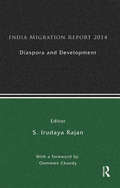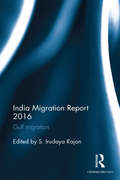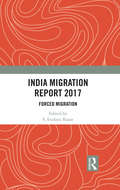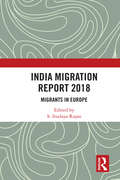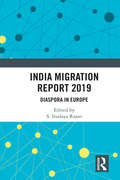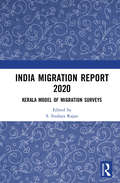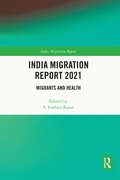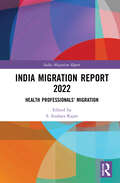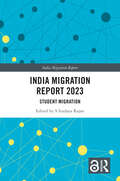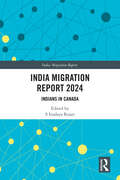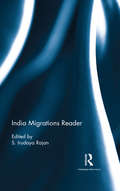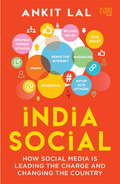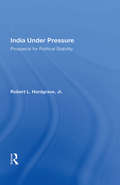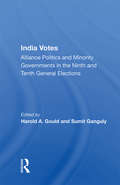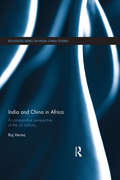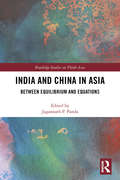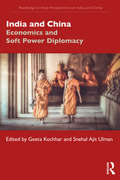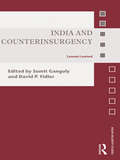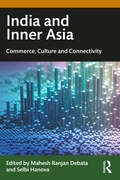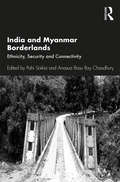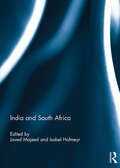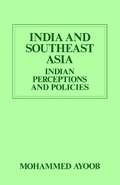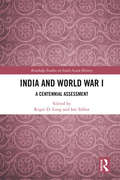- Table View
- List View
India Migration Report 2014: Diaspora and Development (India Migration Report)
by S. Irudaya RajanIndia Migration Report 2014 is one of the first systematic studies on contribution of diasporas in development, in countries of origin as well as destination. This volume: examines how diasporic human and financial resources can be utilized for economic growth and sustainable development, especially in education and health; offers critical insights on migrant experiences, transnationalism and philanthropic networks, and indigenization and diaspora policies, as well as return of diasporas; and includes case studies on Indian migrants in the Gulf region — in particular, Bahrain, Oman and Saudi Arabia — and the United Kingdom, among others. With essays by major contributors, the volume will interest scholars and researchers on economics, development studies, migration and diaspora studies, and sociology. It will also be useful to policy-makers and government institutions working in the area.
India Migration Report 2015: Gender and Migration (India Migration Report)
by S. Irudaya RajanIndia Migration Report 2015 explores migration and its crucial linkages with gender. This volume: • studies important issues such as irregular migration, marriage migration and domestic labour migration, as well as the interconnections of migration, gender and caste; • highlights the relationship between economics and changing gender dynamics brought about by migration; and • documents first-hand experiences of migrants from across India. Part of the prestigious annual series, this work will be useful to scholars and researchers of development studies, economics, migration and diaspora studies, and sociology. It will also interest policy-makers and government institutions working in the area.
India Migration Report 2016: Gulf migration (India Migration Report)
by S. Irudaya RajanIndia Migration Report 2016 discusses migration to the Persian Gulf region. This volume: looks at contemporary labour recruitment and policy, both in India and in the Gulf Cooperation Council (GCC) countries; explores gender issues in migration to Gulf countries; and brings together the latest field data on migrants across states in India. Part of the prestigious annual series, this volume will interest scholars and researchers of economics, development studies, migration and diaspora studies, labour studies, and sociology. It will also be useful to policymakers and government institutions working in the area.
India Migration Report 2017: Forced Migration (India Migration Report)
by S. Irudaya RajanThe India Migration Report 2017 examines forced migration caused by political conflicts, climate change, disasters (natural and man-made) and development projects. India accounts for large numbers of internally displaced people in the world. Apart from conflicts and disasters, over the years development projects (including urban redevelopment and beautification), often justified as serving the interests of the people and for public good, have caused massive displacements in different parts of the country, disrupting the lives and livelihoods of millions of people. The interdisciplinary essays presented here combine a rich mix of research methods and include in-depth case studies on aspects of development-induced displacement affecting diverse groups such as peasants, religious and ethnic minorities, the poor in urban and rural areas, and women, leading to their exclusion and marginalization. The struggles and protests movements of the displaced groups across regions and their outcomes are also assessed. This volume will be of great interest to scholars and researchers of development studies, economics, sociology and social anthropology and migration studies.
India Migration Report 2018: Migrants in Europe
by S. Irudaya RajanIndia Migration Report 2018 looks at Indian migrants in Europe and their lived experiences. It looks at how over the last few decades, the European Union has emerged as the preferred destination for Indian migrants surpassing the United States of America – and is home to Indian students and high-skilled professionals ranging from engineers to medical graduates, contributing to the economy and society both at the countries of origin and destination. The chapters in the volume look at a host of themes and issues, including agreements India has signed with the EU, the Blue Card, the impact of Brexit and the plight of unskilled workers. The volume will be of great interest to scholars and researchers of development studies, economics, sociology and social anthropology and migration studies.
India Migration Report 2019: Diaspora in Europe
by S. Irudaya RajanIndia Migration Report 2019 examines the issues of identity related to integration in European societies. It examines the multifarious nature of social, economic and political engagements of the Indian diaspora with their host societies in Europe. This volume: assesses the historical trends in migration to Europe, mobility paths and transnational networks of skilled Indian migrants, as well as recent tendencies in movements of migrants; explores the roles of Indian migrants in transforming host societies with their skills and capabilities; highlights their contribution towards the development of their homeland through knowledge transfer, philanthropy, capital flows, remittances and investment; takes stock of the impact of recent events, especially Brexit and anti-immigrant positioning of some political parties; uses mixed research methods including ethnography, key informant interviews and in-depth case studies. The volume will be of great interest to scholars and researchers of development studies, economics, demography, sociology and social anthropology, and migration and diaspora studies.
India Migration Report 2020: Kerala Model of Migration Surveys
by S. Irudaya RajanIndia Migration Report 2020 examines how migration surveys operate to collect, analyse and bring to life socio-economic issues in social science research. With a focus on the strategies and the importance of information collected by Kerala Migration Surveys since 1998, the volume: Explores the effect of male migration on women left behind; attitudes of male migrants within households; the role of transnational migration and it effect on attitudes towards women; Investigates consumption of remittances and their utilization; asset accumulation and changing economic statuses of households; financial inclusion of migrants and migration strategies during times of crises like the Kerala floods of 2018; Highlights the twenty-year experience of the Kerala Migration Surveys, how its model has been adapted in various states and led to the proposed large-scale India Migration Survey; and Explores issues of migration politics and governance, as well as return migration strategies of other countries to provide a roadmap for India. The volume will be of interest to scholars and researchers of development studies, economics, demography, sociology and social anthropology, and migration and diaspora studies.
India Migration Report 2021: Migrants and Health (India Migration Report)
by S. Irudaya RajanIndia Migration Report 2021 presents a detailed study on the health of migrants. It highlights major healthcare challenges faced by migrant labourers, especially in the context of the COVID-19 pandemic, which has forced authorities, policymakers and many other stakeholders to turn their attention to healthcare delivery unlike ever before. Bringing to the fore the health status of the migrant population both before the pandemic and during the pandemic, the essays in this volume discuss • the ease of access of migrant labourers to primary healthcare services; • the safety challenges faced by migrant workers at their workplaces, their exposure to various physical and psychological health vulnerabilities, and prevalence of potentially malignant health disorders and mental health issues among migrant labourers; • gendered access to healthcare, gender-based violence at workplaces and the gender-related perceptions on topics such as employment, decision-making and general attitude; • the role of decentralization and local self-government institutions in enabling health systems to address health problems of migrants, government policies and programs aimed at providing welfare for return emigrants from the Gulf; • the vulnerabilities migrant workers have encountered across the Indian states during the pandemic, with regards to food insecurity and psychological distress, and the type of support they received from various stakeholders. The volume will be of interest to scholars and researchers of development studies, economics, demography, sociology and social anthropology, and migration and diaspora studies.
India Migration Report 2022: Health Professionals' Migration (India Migration Report)
by S. Irudaya RajanIndia Migration Report 2022 is one of the first volumes to focus comprehensively on Indian health professionals’ migration. The essays in the volume discuss the reasons, challenges and opportunities that daunt and prompt health professionals to migrate within and outside India. This volume: • Explores the history of migration of health professionals, especially nurses from India; • Focuses in economic and social drivers of migration among health professionals; • Examines shifting patterns in migration as well as emergence of new destinations for migrants; • Studies the economic and social impact of COVID-19 among migrant health professionals; • Highlights the influence of remittances on rural economies in India. Timely, data-driven and drawing on exhaustive fieldwork, the volume looks at Indian health professionals in North America, Middle East, Asia Pacific and South Asia. It will be of interest to scholars and researchers of development studies, public health, public policy, economics, demography, sociology and social anthropology, and migration and diaspora studies.
India Migration Report 2023: Student Migration (India Migration Report)
by S Irudaya RajanThe India Migration Report 2023: Student Migration is one of the first books that attempts to comprehensively explore the various nuances of Indian international student migration factoring in multiple factors that influence the migration journey of Indian students. It also looks into other migration stories including internal and international returnees, various impacts of remittances, and migration in the context of the pandemic.This volume: Inspect the factors driving the student migration from India, accounting for both the historical and current happenings influencing these factors. Following the pandemic, the book highlights the challenges faced by Indian international students in accessing health care and other related services which goes on to push them into vulnerable situations Outlines the reasoning behind Indian students' decision to emigrate and how families play an important role in influencing key migration decisions made by students and the different patterns of student migration observed in India Examines the employment challenges experienced, particularly following the COVID-19 pandemic, by the highly skilled Indian migrants and Indian international students Describes the role that recruitment and consultancy agencies play in international student mobility (ISM) and examines the intricate relationship between migrant agencies and migration facilitation Investigates the psychological, economic and social challenges faced by Indian international students during their migration journey both during and after the completion of their course abroad Provides a critical overview of the conditions of both internal and international returnees to different parts of India Studies the impact of remittances on migrant households including their consumption patterns and human capital investment Analyses interstate migration networks through the prism of gender and critically assesses how gender migration patterns have altered throughout time Scholars, students, researchers, academicians, policymakers or anyone with an interest in migration, migration politics, economics, social psychology, migration policies, development studies, sociology, social anthropology and gender studies will find this book on Indian student migration extremely informative. The book is a comprehensive collection of various studies that look into the multiple aspects of student migration but also extend to other pertinent issues of Indian migration that are extremely relevant at this given point in time.
India Migration Report 2024: Indians in Canada (India Migration Report)
by S Irudaya RajanIndia Migration Report 2024: Indians in Canada is one of the first volumes to comprehensively examine and analyse the different facets of Indian migration to Canada.This volume:• Examines the comprehensive history of Indian migration to Canada, including the story of social, cultural, economic, and political integration, analysis of socio-economic characteristics, and evolving political scenarios surrounding student migration and diasporas.• Presents an overview of migration and post-migration experiences of Indian immigrant and Indo-Canadian women and the rising trend of high-skilled Indian female migration to Canada.• Discusses the influence of Canadian immigration policy and its effects on the changing immigration patterns of Indians to Canada.• Examines the challenges faced by Indian immigrants and Indo-Canadians due to deeply entrenched Eurocentric and Ethnocentric biases and the impact of COVID-19 on the community.• Explores the effect of adult children’s migration on the health and suffering from disability of elderly left behind in the migration process.The book also discusses leveraging migration for international development. The book will be of interest to scholars, students, researchers, or anyone interested in migration and diasporic studies, development studies, the politics of migration, immigration policy, social anthropology, economics, and sociology.
India Migrations Reader
by S. Irudaya RajanThis volume brings together critical and landmark studies in Indian migration. Covers a range of key themes — emigration policy in countries of destination and origin, development and remittances, gender issues, impact of the global financial crisis, conflict, and inclusive growth Looks at new and emerging patterns in Indian migration Includes essays by major scholars in the field The book will be useful to scholars and researchers of development studies, migration and diaspora studies, economics and sociology. It will also interest policymakers and government institutions working in the area.
India Social: HOW SOCIAL MEDIA IS LEADING THE CHARGE AND CHANGING THE COUNTRY
by Ankit Lal`As a pioneer in the age when social media has become India?s new political pulpit and argumentative townsquare, Ankit Lal is perfectly poised to chronicle India?s transformational tryst with Twitter and Facebook and whatever comes next.? ? SHEKHAR GUPTA, senior journalist and recipient of the Padma Bhushan `This book is a must-read for anyone who wants to understand how social media has shaped India in the past decade.? ? ARVIND KEJRIWAL, chief minister, Delhi In India Social, social media activist and influencer Ankit Lal takes a deep dive into India?s biggest social media campaigns and analyses how, in just the last ten years, platforms like Facebook, Twitter, YouTube and WhatsApp have changed the way Indians engage with politics, popular culture and social revolution. From the 2008 Mumbai terror attacks, which unleashed the potential of the medium, to the 2012 #IndiaAgainstCorruption protests; from the rage-filled Justice for Nirbhaya movement to the citizen-driven fight for a free Internet with the #NetNeutrality campaign; from the controversial #AIBRoast to WhatsApp becoming the primary tool used to spread the agenda and ideology of major political parties ? India Social unravels, for the first time, the behind-the-scenes stories of the most influential social media movements of the past decade. Incisive and insightful, India Social is the story of how they began, why they spread and the way they have reshaped democratic life in India.
India Under Pressure: Prospects For Political Stability
by Robert L. HardgraveIndia, as the dominant power in South Asia, is the region’s keystone for stability. Contending that the Indian government is under ever-increasing pressure as a result of internal social and political conflict, Dr. Hardgrave provides a broad survey of the sources of conflict: regionalism, particularly demands for separation and autonomy in Assam and the Punjab; enmity between religious groups, manifested in increased Hindu-Muslim tensions; caste violence; peasant unrest in the countryside; and protests among students and labor groups in the cities. The author analyzes the capacity of India’s political parties, the bureaucracy, and the military to cope with change and to manage the country’s social diversity and the potential for conflict. In particular, he examines the ruling Congress party, the leadership style of Prime Minister Indira Gandhi, the problem of succession, prospects for unity among opposition parties, and the potential impact of a coalition government on political stability. In considering the role that foreign relations play in India’s political stability, Dr. Hardgrave discusses India’s relations with South Asia, the Middle East, the Soviet Union, China, and the United States.
India Votes: Alliance Politics And Minority Governments In The Ninth And Tenth General Elections
by Harold A GouldWithin a scant eighteen-month span, India held two national elections. The first, in November 1989, witnessed the political demise of Rajiv Gandhi and the precipitous decline of his Congress Party. The second, in May 1991, witnessed his assassination at the hands of Tamil Tiger extremists just as the Congress Party seemed poised on the threshold of
India and China in Africa: A comparative perspective of the oil industry (Routledge Series on India-China Studies)
by Raj VermaWith their phenomenal growth rates, India and China are surging ahead as world economic powers. Due to increasing instability in the Middle East, they have turned to Africa to procure oil to fuel their industrialisation process. Africa’s economy stands to be impacted in various ways due to the increasing interaction with these ‘Asian Giants’. This book analyses the acquisition of oil blocks by Indian and Chinese oil corporations in eleven West African countries. It describes the differences in how India and China mobilise oil externally to meet their respective goals and objectives. The book examines the rate of return on capital, rate of interest on loans and the ease of availability of loans, the difference in the level of technology and ability to acquire technology, project management skills, risk aversion, valuation of the asset and the difference in the economic, political and diplomatic support received by the Chinese and Indian oil companies from their respective governments. It is argued that the difference in the relative economic and political power of India and China accounts for the ability of Chinese oil companies to outbid their Indian competitors and/or be preferred as partners by international oil companies. Containing interviews from Indian and Chinese oil company executives, government officials, industry officials, former diplomats and scholars and academics from India, China and the UK, this book makes a valuable contribution to existing literature on India, China and the oil industry in West Africa. It will be a valuable resource for academics in the field of International Relations, Foreign Policy Analysis, Asian Business and Economics.
India and China in Asia: Between Equilibrium and Equations (Routledge Studies on Think Asia)
by Jagannath P. PandaThis book analyses the structure of the India–China relationship and the two prominent powers’ positions with and against each other, bilaterally and globally, in a complex Asian environment and beyond. India and China’s perceptions of one another are evaluated to reveal how the order of Asia is influenced by engaging in different power equations that affect equilibrium and disequilibrium. Contributors address three critical perspectives of India and China in Asia which are increasingly shaping the future of Asia and impacting the Indo-Pacific power balance. First, they examine the mutual perceptions of India and China as an integral part of Asia’s evolving politics and the impact of this on the emerging Asian order and disorder. Second, they assess how classical and contemporary characteristics of the India–China boundary and beyond-border disputes or conflicts are shaping Asia’s political trajectory and leaving an impact on the Indo-Pacific region. Additionally, contributors observe the prevailing power equations in which India and China are currently engaged to reveal that they are not only geographically limited to the Asian region. Instead, having a strong global or intercontinental character attached to it, the India–China relationship involves extra-territorial powers and extra-territorial regions. This book will be of interest to academics, students and policymakers working on Asian studies, international relations, area studies, emerging powers studies, strategic studies, security studies and conflict studies.
India and China: Economics and Soft Power Diplomacy (Routledge Critical Perspectives on India and China)
by Geeta Kochhar Snehal Ajit UlmanThis book looks at the changing dynamics of diplomacy of the two emerging global powers – India and China. It examines trade relations, cultural ties and economic engagements of both countries and their shifting influence in the region surrounding them. This volume takes an in-depth look at the trade and economic strategies of India and China through the prism of soft power diplomacy. It reflects on the challenges the two countries face over bilateral trade negotiations, BRICS and China’s Silk Road project, along with other issues of foreign policy. The book underlines the decisive role of the soft power approach and greater people-to-people contact in the global strategies of India and China and in fostering greater cooperation in the region. The book will be of great interest to researchers and students of international relations, political science, public policy and international communications. It will also be useful for think tanks, policy makers and general readers who are interested in the India-China relationship and the politics of soft power diplomacy.
India and Counterinsurgency: Lessons Learned (Asian Security Studies)
by Sumit Ganguly David P. FidlerThis edited volume focuses on India's experiences waging counterinsurgency campaigns since its independence in 1947. Filling a clear gap in the literature, the book traces and assess the origins, evolution and current state of India's counterinsurgency strategies and capabilities, focusing on key counterinsurgency campaigns waged by India within and outside its territory. It also analyzes the development of Indian doctrine on counterinsurgency, and locates this within the overall ebb and flow of India's defense and security policies. The central argument is that counterinsurgency has been an integral part of India's overall security policy and can thereby impart much to political and military leaders in other states. Since its emergence from British colonialism, India's defence policies have not merely sought to protect and preserve India's inherited colonial borders from threats by rival states, but have also sought to prevent and suppress secessionist movements. In countering insurgencies, the Indian state has fashioned strategies that seek to repress militarily any secessionist movement, while simultaneously forging a range of civilian administrative and institutional arrangements that attempt to address the grievances of disaffected populations. The book highlights key strategic and tactical innovations that the Indian Army and security forces made to deal with a range of insurgent movements. Simultaneously, it also examines how the civilian-military nexus enabled India's policy makers to utilize existing, and formulate novel, institutional means to address extant political grievances. India has been most successful where it has managed to use calibrated force, obtained the trust of much of the aggrieved population and made persuasive commitments to political and institutional reform. Examination of these elements of India's counterinsurgency performance can be compared to counterinsurgency doctrine developed by other countries, including the United States, and thus yield comparative policy prescriptions and recommendations that can be applied to other counterinsurgency contexts. This book will be of great interest to students of counterinsurgency and irregular warfare, Indian politics, Asian Security Studies and Strategic Studies in general.
India and Inner Asia: Commerce, Culture and Connectivity
by Mahesh Ranjan Debata Selbi HanovaThis book studies India’s historical, socio-cultural, and trade linkages with Inner Asia. Inner Asia includes the landlocked regions within East Asia and North Asia that are part of today's Western China, Mongolia, the Russian Far East, and Siberia. The volume examines issues of geopolitics, geoeconomics, climate change, regional cooperation, and discusses the importance of the fabled Silk Road for the countries of Inner Asia. It also analyses the impact India has wielded upon the region through its cultural traits and how Buddhism has remained a binding force between the people of the two regions. Lucid and topical, this book will be of useful for scholars and researchers of Asian studies, central Asian studies, area studies, geopolitics, international trade, international relations, defence and strategic studies, diplomacy and foreign policy, and political studies. It will also be of interest to policymakers, bureaucrats, diplomats and think tanks.
India and Its Visual Cultures: Community, Class and Gender in a Symbolic Landscape
by Dr Uwe Skoda Dr Birgit LettmannIndia and Its Visual Cultures is a comprehensive mapping and analysis of contemporary cultural artefacts and visual cultures through different approaches—iconographic, social, political, religious and so on. This book covers various media and their histories by studying visual representational systems, production and consumption of media and culture-specific understandings. Crucial questions about the usage of media in research are also addressed in the book. In the selection of the subjects and objects of enquiry, there is a constant engagement with the popular and the everyday. The objects are studied with respect to their situatedness in urban space and everyday life. The five sections of the book focus on five aspects of visual culture: camera works, folk/artistry, market signs, pictorial politics and monumental landscapes. With attention to ethnographic detail and anthropology, each section brings an added dimension to the study of visible cultural forms.
India and Myanmar Borderlands: Ethnicity, Security and Connectivity
by Pahi Saikia Anasua Basu Ray ChaudhuryThis book explores the India–Myanmar relationship in terms of ethnicity, security and connectivity. With the process of democratic transition in Myanmar since 2011 and the ongoing Rohingya crisis, issues related to cross-border insurgency are one of the most important factors that determine bilateral ties between the two neighboring countries. The volume discusses a diverse range of themes – historical dimensions of cooperation; contested territories, resistance and violence in India–Myanmar borderlands; ethnic linkages; political economy of India–Myanmar cooperation; and Act East Policy – to examine the prospects and challenges of the strategic partnership between India and Myanmar, and analyzes further possibilities to move forward. The chapters further look at cross-border informal commercial exchanges, public health, population movements, and problems of connectivity and infrastructure projects. Comprehensive, topical and with its rich empirical data, the volume will be useful to scholars and researchers of political studies, international relations, security studies, foreign policy, contemporary history, and South Asian studies as well as government bodies and think tanks.
India and South Africa
by Javed Majeed and Isabel HofmeyrSouth Africa and India constitute two key nodes in the global south and have inspired new modes of non-Western transnational history. Themes include anti-imperial movements; Gandhian ideas; comparisons of race and caste; Afro-Asian ideals; Indian Ocean public spheres. This volume extends these debates into the cultural and linguistic terrain. The book combines the methods of Indian Ocean studies and Comparative Cultural Studies, both committed to moving beyond the nation state. Case studies explore classics and concomitant ideas of civilisation, colonial linguistics and the history of languages, and theatre. Topics include the use of classics by colonisers and the colonised in British India and South Africa differences between South African Indian English and Indian English how the Linguistic Survey of India conflicted with colonial and nationalist mappings of India and its references to African languages the rise of ‘Hinglish’ in contemporary India a South African play dealing with African-Indian interactions. This bookw as published as a special issue of African Studies.
India and Southeast Asia: Indian Perceptions and Policies (Routledge Revivals)
by Mohammed AyoobThis title, first published in 1990, provides a close contextual analysis of how influential Indian policy-makers have perceived India's interests within the ASEAN region since Indian independence in 1947. Placing these perceptions in the context of India's broad strategic and foreign policy framework, Ayoob analyses the policies which had emerged by the close of the 1980s and stresses the close link between the futures of the two regions. Including a thorough analysis of superpower involvement, as well as Indian relations with Indonesia, Vietnam and Cambodia, this is a comprehensive study of great value to students with an interest in Indian and Southeast Asian history and diplomacy.
India and World War I: A Centennial Assessment (Routledge Studies in South Asian History)
by Ian Talbot Roger D. LongWorld War I directly and indirectly caused events and social and political trends which defined the history of the world for the rest of the century, including the Russian Revolution and the rise of communism to the Great Crash of 1929 which lead to the Great Depression and the rise of Hitler and Nazi Germany. It marked a turning point in world history as the end of the historical era of European dominance and the ushering in of a period which accelerated demands for freedom and autonomy in colonial settings. India played a significant role in the war and in the Allied victory on the battlefield. This book explores India’s involvement in the Great War and the way the war impacted upon the country from a variety of different viewpoints including case studies focusing on key individuals who played vital roles in the war. The long and short term impacts of the war on different locations in India are also explored in the chapters which offer an analysis of the importance of the war on India while commemorating the sacrifices which were made. A new, innovative and multidisciplinary examination of India and World War I, this book presents a select number of case studies showing the intimate relationship of the global war and its social, political and economic impacts on the Indian subcontinent. It will be of interest to academics in the field of War Studies, Colonial and Imperial History and South Asian and Modern Indian History.
